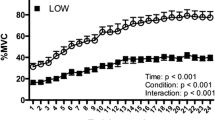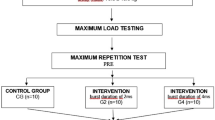Abstract
Purpose
Neuromuscular electrical stimulation (NMES) with large electrodes and multiple current pathways (m-NMES) has recently been proposed as a valid alternative to conventional NMES (c-NMES) for quadriceps muscle (re)training. The main aim of this study was to compare discomfort, evoked force and fatigue between m-NMES and c-NMES of the quadriceps femoris muscle in healthy subjects.
Methods
Ten healthy subjects completed two experimental sessions (c-NMES and m-NMES), that were randomly presented in a cross-over design. Maximal electrically evoked force at pain threshold, self-reported discomfort at different levels of evoked force, and fatigue-induced force declines during and following a series of 20 NMES contractions were compared between c-NMES and m-NMES.
Results
m-NMES resulted in greater evoked force (P < 0.05) and lower discomfort in comparison to c-NMES (P < 0.05–0.001), but fatigue time course and magnitude did not differ between the two conditions.
Conclusions
The use of quadriceps m-NMES appears legitimate for (re)training purposes because it generated stronger contractions and was less discomfortable than c-NMES (due to multiple current pathways and/or lower current density with larger electrodes).





Similar content being viewed by others
Abbreviations
- c-NMES:
-
Conventional neuromuscular electrical stimulation
- m-NMES:
-
Multipath neuromuscular electrical stimulation
- MVC:
-
Maximal voluntary contraction
- NMES:
-
Neuromuscular electrical stimulation
- SD:
-
Standard deviation
- VAS:
-
Visual analogue scale
References
Adams GR, Harris RT, Woodard D, Dudley GA (1993) Mapping of electrical muscle stimulation using MRI. J Appl Physiol 74:532–537
Alon G (1985) High voltage stimulation. Effects of electrode size on basic excitatory responses. Phys Ther 65:890–895
Bax L, Staes F, Verhagen A (2005) Does neuromuscular electrical stimulation strengthen the quadriceps femoris? A systematic review of randomised controlled trials. Sports Med 35:191–212
Bennie SD, Petrofsky JS, Nisperos J, Tsurudome M, Laymon M (2002) Toward the optimal waveform for electrical stimulation of human muscle. Eur J Appl Physiol 88:13–19
Bickel CS, Gregory CM, Dean JC (2011) Motor unit recruitment during neuromuscular electrical stimulation: a critical appraisal. Eur J Appl Physiol 111:2399–2407
Botter A, Merletti R, Minetto MA (2009) Pulse charge and not waveform affects M-wave properties during progressive motor unit activation. J Electromyogr Kinesiol 19:564–573
Bowman BR, Baker LL (1985) Effects of waveform parameters on comfort during transcutaneous neuromuscular electrical stimulation. Ann Biomed Eng 13:59–74
Burke D, Mackenzie RA, Skuse NF, Lethlean AK (1975) Cutaneous afferent activity in median and radial nerve fascicles: a microelectrode study. J Neurol Neurosurg Psychiatry 38:855–864
Delitto A, Strube MJ, Shulman AD, Minor SD (1992) A study of discomfort with electrical stimulation. Phys Ther 72:410–421
Doheny EP, Caulfield BM, Minogue CM, Lowery MM (2010) Effect of subcutaneous fat thickness and surface electrode configuration during neuromuscular electrical stimulation. Med Eng Phys 32:468–474
Feil S, Newell J, Minogue C, Paessler HH (2011) The effectiveness of supplementing a standard rehabilitation program with superimposed neuromuscular electrical stimulation after anterior cruciate ligament reconstruction: a prospective, randomized, single-blind study. Am J Sports Med 39:1238–1247
Gandevia SC (2001) Spinal and supraspinal factors in human muscle fatigue. Physiol Rev 81:1725–1789
Gobbo M, Gaffurini P, Bissolotti L, Esposito F, Orizio C (2011) Transcutaneous neuromuscular electrical stimulation: influence of electrode positioning and stimulus amplitude settings on muscle response. Eur J Appl Physiol 111:2451–2459
Gondin J, Cozzone PJ, Bendahan D (2011) Is high-frequency neuromuscular electrical stimulation a suitable tool for muscle performance improvement in both healthy humans and athletes? Eur J Appl Physiol 111:2473–2487
Gorgey AS, Dudley GA (2008) The role of pulse duration and stimulation duration in maximizing the normalized torque during neuromuscular electrical stimulation. J Orthop Sports Phys Ther 38:508–516
Gregory CM, Bickel CS (2005) Recruitment patterns in human skeletal muscle during electrical stimulation. Phys Ther 85:358–364
Gregory CM, Dixon W, Bickel CS (2007) Impact of varying pulse frequency and duration on muscle torque production and fatigue. Muscle Nerve 35:504–509
Kebaetse MB, Lee SC, Binder-Macleod SA (2001) A novel stimulation pattern improves performance during repetitive dynamic contractions. Muscle Nerve 24:744–752
Kesar T, Chou LW, Binder-Macleod SA (2008) Effects of stimulation frequency versus pulse duration modulation on muscle fatigue. J Electromyogr Kinesiol 18:662–671
Lai H, De Domenico G, Strauss G (1988) The effect of different electro-motor stimulation training intensities on strength improvement. Aust J Physiother 34:151–164
Laufer Y, Snyder-Mackler L (2010) Response of male and female subjects after total knee arthroplasty to repeated neuromuscular electrical stimulation of the quadriceps femoris muscle. Am J Phys Med Rehabil 89:464–472
Laufer Y, Ries JD, Leininger PM, Alon G (2001) Quadriceps femoris muscle torques and fatigue generated by neuromuscular electrical stimulation with three different waveforms. Phys Ther 81:1307–1316
Lexell J, Henriksson-Larsen K, Sjostrom M (1983) Distribution of different fibre types in human skeletal muscles. 2. A study of cross-sections of whole m. vastus lateralis. Acta Physiol Scand 117:115–122
Lieber RL, Kelly MJ (1991) Factors influencing quadriceps femoris muscle torque using transcutaneous neuromuscular electrical stimulation. Phys Ther 71:715–721
Lyons GM, Leane GE, Clarke-Moloney M, O’Brien JV, Grace PA (2004) An investigation of the effect of electrode size and electrode location on comfort during stimulation of the gastrocnemius muscle. Med Eng Phys 26:873–878
Maffiuletti NA (2010) Physiological and methodological considerations for the use of neuromuscular electrical stimulation. Eur J Appl Physiol 110:223–234
Maffiuletti NA, Minetto MA, Farina D, Bottinelli R (2011) Electrical stimulation for neuromuscular testing and training: state-of-the art and unresolved issues. Eur J Appl Physiol 111:2391–2397
Maffiuletti NA, Roig M, Karatzanos E, Nanas S (2013) Neuromuscular electrical stimulation for preventing skeletal-muscle weakness and wasting in critically ill patients: a systematic review. BMC Med 11:137
Malesevic NM, Popovic LZ, Schwirtlich L, Popovic DB (2010) Distributed low-frequency functional electrical stimulation delays muscle fatigue compared to conventional stimulation. Muscle Nerve 42:556–562
Morch CD, Hennings K, Andersen OK (2011) Estimating nerve excitation thresholds to cutaneous electrical stimulation by finite element modeling combined with a stochastic branching nerve fiber model. Med Biol Eng Comput 49:385–395
Naaman SC, Stein RB, Thomas C (2000) Minimizing discomfort with surface neuromuscular stimulation. Neurorehabil Neural Repair 14:223–228
Neyroud D, Maffiuletti NA, Kayser B, Place N (2012) Mechanisms of fatigue and task failure induced by sustained submaximal contractions. Med Sci Sports Exerc 44:1243–1251
Paessler HH (2012) Emerging techniques in orthopedics: advances in neuromuscular electrical stimulation. Am J Orthop 41:1–8
Parker MG, Berhold M, Brown R, Hunter S, Smith MR, Runhling RO (1986) Fatigue response in human quadriceps femoris muscle during high frequency electrical stimulation. J Orthop Sports Phys Ther 7:145–153
Place N, Maffiuletti NA, Martin A, Lepers R (2007) Assessment of the reliability of central and peripheral fatigue after sustained maximal voluntary contraction of the quadriceps muscle. Muscle Nerve 35:486–495
Snyder-Mackler L, Delitto A, Stralka SW, Bailey SL (1994) Use of electrical stimulation to enhance recovery of quadriceps femoris muscle force production in patients following anterior cruciate ligament reconstruction. Phys Ther 74:901–907
Stevens-Lapsley JE, Balter JE, Wolfe P, Eckhoff DG, Kohrt WM (2012) Early neuromuscular electrical stimulation to improve quadriceps muscle strength after total knee arthroplasty: a randomized controlled trial. Phys Ther 92:210–226
Theurel J, Lepers R, Pardon L, Maffiuletti NA (2007) Differences in cardiorespiratory and neuromuscular responses between voluntary and stimulated contractions of the quadriceps femoris muscle. Respir Physiol Neurobiol 157:341–347
Vanderthommen M, Duchateau J (2007) Electrical stimulation as a modality to improve performance of the neuromuscular system. Exerc Sport Sci Rev 35:180–185
Vanderthommen M, Duteil S, Wary C, Raynaud JS, Leroy-Willig A, Crielaard JM, Carlier PG (2003) A comparison of voluntary and electrically induced contractions by interleaved 1H- and 31P-NMRS in humans. J Appl Physiol 94:1012–1024
Vivodtzev I, Debigare R, Gagnon P, Mainguy V, Saey D, Dube A, Pare ME, Belanger M, Maltais F (2012) Functional and muscular effects of neuromuscular electrical stimulation in patients with severe COPD: a randomized clinical trial. Chest 141:716–725
Walls RJ, McHugh G, O’Gorman DJ, Moyna NM, O’Byrne JM (2010) Effects of preoperative neuromuscular electrical stimulation on quadriceps strength and functional recovery in total knee arthroplasty. A pilot study. BMC Musculoskelet Disord 11:119
Zory R, Boerio D, Jubeau M, Maffiuletti NA (2005) Central and peripheral fatigue of the knee extensor muscles induced by electromyostimulation. Int J Sports Med 26:847–853
Acknowledgments
The authors thank Bio-Medical Research Ltd. (Galway, Ireland) for logistical support during the experimental phase of the study.
Conflict of interest
The authors declare no conflict of interest regarding this study.
Author information
Authors and Affiliations
Corresponding author
Additional information
Communicated by Toshio Moritani.
Rights and permissions
About this article
Cite this article
Maffiuletti, N.A., Vivodtzev, I., Minetto, M.A. et al. A new paradigm of neuromuscular electrical stimulation for the quadriceps femoris muscle. Eur J Appl Physiol 114, 1197–1205 (2014). https://doi.org/10.1007/s00421-014-2849-2
Received:
Accepted:
Published:
Issue Date:
DOI: https://doi.org/10.1007/s00421-014-2849-2




